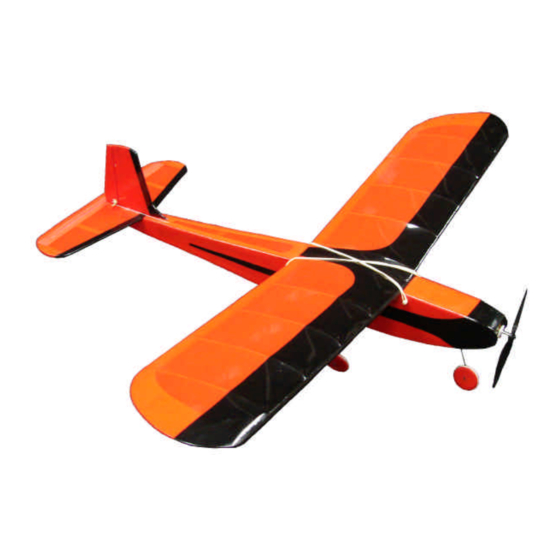
Summary of Contents for Mountain Models PeregrinE Micro
- Page 1 PeregrinE Micro™ Micro Nostalgic R/C Electric Airplane PeregrinE™ Specifications Wingspan: 23.7 in. Length: 18.4 in. Wing Area: 100 sq. in. Weight (Ready to Fly): 1.8 oz. Wing Loading: 2.6 oz. / sq. ft. Version 1.0, February 16, 2011...
-
Page 2: Warranty
WARRANTY Mountain Models guarantees this kit to be free from any defects in both material and workmanship at the time of purchase. This warranty does not cover ANY components or parts damaged by use or modification. In no case shall Mountain Model’s liability exceed the original cost of the purchased kit. Mountain Models reserves the right to modify or change this warranty without notice. -
Page 3: Before You Begin
Before You Begin Check to make sure that all of your parts are there and in good shape. Parts List Number Description of Part in Kit Bundled Parts Laser Cut Parts Sheets (6 Sheets) Plan Sheets (11” x 17”) These instructions of course! Metal (on the back of the wood bundle) 0.020”... -
Page 4: General Building Tips
General Building Tips • READ THE INSTRUCTIONS all the way through and study the plans BEFORE starting any work on the model. • PRE-SANDING: BEFORE removing any parts from the balsa sheets, use a sanding block with 320 grit sandpaper and lightly sand the back of the balsa sheets. Our balsa suppliers have been sending us wood that is over sized, so sanding the backs of the balsa sheets reduces the thickness just slightly and removes any charring from the laser cutting process. - Page 5 1. Slide the 4 ea. W5 ribs, W6 rib, and W7 rib onto the LEFT side of the spars, W1 and W2. Be careful with W6 and W7 since the spars do not rest on your table there. Use a finger on the bottom of the spars when pressing these ribs in place.
- Page 6 8. Slide the 4 ea. W5 ribs, W6 rib, and W7 rib onto the RIGHT side of the spars, W1 and W2. Be careful with W6 and W7 since the spars do not rest on your table there. Use a finger on the bottom of the spars when pressing these ribs in place.
- Page 7 12. Press the W9 leading edge onto W3 and fully up against the ribs. Do NOT glue. 13. After making SURE that all the parts are fully seated against each other and aligned with the plans, and holding the parts down FLAT (small weights are great for this), secure all the joints with thin CA.
- Page 8 16. Glue the F22 cross brace into F13. Glue the F23 brace into F16. Glue the F21 braces into the fuselage sides. 17. Press F1 into the plywood F2 part, making SURE that the text on F2 is facing FORWARD and the text on F1 is facing UP. Press F1 into F3. Press F4 into F1.
- Page 9 19. Press the crutch assembly into one fuselage side. 20. Press the other fuselage side onto the crutch assembly. After checking that all parts are fully pressed together, lightly tack the joints with thin CA. 21. Glue the F19 parts to the inside of the fuselage sides, as shown, so the holes line up.
- Page 10 22. Glue F7a and F7b together and then press F7 in place and glue with thin CA. 23. Press the F9 and F15 parts in place, but do NOT glue yet.
- Page 11 24. Press F8 in place between F2 and F9. Press F14 in place between F5 and F15. Press the parts together and secure with thin CA. 25. Press F10 in place and glue with thin CA.
- Page 12 26. Press F12 into F11 and then press in place between the fuselage sides. Do NOT glue it yet. 27. Press F13 in place on the fuselage top, with the pushrod slot on the RIGHT side of the fuselage. Make sure the fuselage is straight and square and secure the joints with F11, F12, and F13 with thin CA.
- Page 13 28. Glue the F20 parts in place in the inside of the fuselage sides. 29. Press F13 in place. Once again, ensure that the fuselage is straight and glue with thin CA. 30. Lightly sand the fuselage with 320 grit sandpaper.
- Page 14 34. Assemble the horizontal stabilizer and vertical fin, as shown on the plans, with thin CA. 35. Lightly sand the stab, elevator, vertical fin, and rudder with 320 grit sandpaper. 36. Cover your airplane with SoLite, tissue, or silkspan. Do NOT use heavier coverings, as this is a light weight model and heavier coverings can easily damage the structure of the wings and tails.
- Page 15 38. Cut the 1/8" dowel to 2 lengths that are 1-13/16" in length. Install in the fuselage, as shown on the plans. 39. Hinge the elevator to the stabilizer using hinge tape, as shown on the plans. There should be a small (1/64") gap between the parts.
- Page 16 41. Glue the stabilizer/vertical to the fuselage. Follow the direction on the plan sheet! 42. Follow the directions on page 2 of the plans to make and install the pushrods and control horns. 43. Slide the control horn onto the Z-Bend and then glue the control horn into the elevator.
- Page 17 Velcro, mount the wing, and balance your model where shown on the plans. 45. Enjoy flying your PeregrinE Micro model! If you need help learning how to fly, as around at a local hobby shop or contact the AMA (Academy of Model...










Need help?
Do you have a question about the PeregrinE Micro and is the answer not in the manual?
Questions and answers